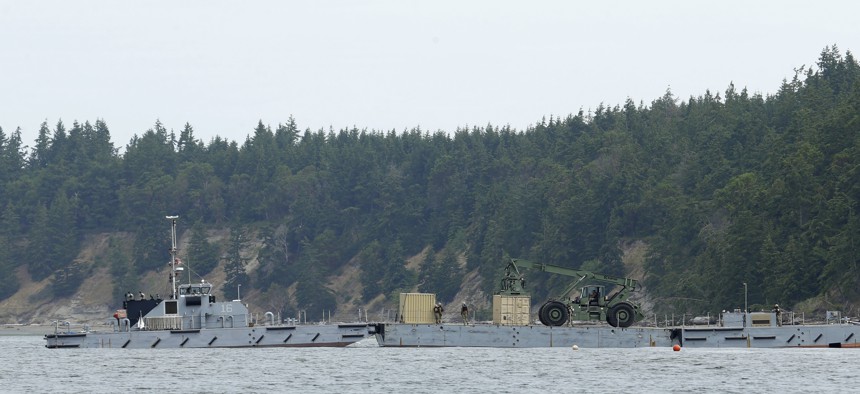Pentagon Advances Experiments with Autonomous Barges to Replenish Aircraft

U.S. Navy sailors move a cargo container from a modular barge to shore, Wednesday, June 8, 2016, on Naval Magazine Indian Island in Washington state, as part of a massive earthquake and tsunami drill called Cascadia Rising. The drill is built around the premise of a 9.0 magnitude earthquake 95 miles off of the coast of Oregon that results in a tsunami. (AP Photo/Ted S. Warren)
The next phase of an existing agreement commits millions to demonstrate this emerging technology.
The Defense Department is set to trial a full-scale autonomous ocean-going replenishment system comprised of technology-driven kits that transform existing barges into self-moving platforms that can land and refuel military aircraft.
They’ll make up a network of smart, floating military gas or resupply stations.
Autonomous marine navigation company Sea Machines is the prime contractor steering the work. On Thursday, the Boston-based business announced the advancement of a multi-year other transaction agreement between it and the Defense Innovation Unit, or DIU, which focuses on rapid prototyping of autonomy projects for the department.
This move to the second phase of this OTA-based work commits up to $3.1 million to the experimentation and deployment of this work. Through it, Defense and industry officials aim to push forward the military’s operational capabilities at sea—with help from autonomous technologies.
“The ‘kit’ converts conventional deck barges into self-propelled, expeditionary platforms that can replenish rotary wing aircraft, surface vessels, and shore stations,” Philip Bourque, Sea Machines’ head of business development, told Nextgov in an email on Thursday. “The ‘kit’ itself is essentially an engineered assembly of certain expeditionary components that meet the DOD criteria for refueling, but also landing those aircraft.”
Bourque noted that this work stems from a solicitation the U.S. startup submitted a response to, which led to a competitive down-select and award. Last October, Sea Machines was tapped to engineer those computer vision-equipped kits and show what they are capable of. Now, the work is transitioning to the proof-of-concept stage. Huntington Ingalls, Bell Flight and FOSS Maritime are assisting Sea Machines in this pursuit. The latter—a Seattle-based maritime transportation and logistics provider—will provide the “naval architecture, support engineering, and operations management to outfit a remotely commanded deck barge to land helicopters and host a scaled fueling station for aircraft, surface vessels, and shore replenishment,” according to a press release shared with Nextgov.
Sea Machines’ autonomy and propulsion technology enables the platforms to run as self-propelled barges. And “the barges are used to solve logistics challenges for replenishing key assets,” Bourque further explained.
Originally, the company produced a packaged solution for autonomous command and control of surface vessels meant for the commercial market. DOD took note of the product’s potential to meet its own, forward-looking needs since then, tapping the company to serve the U.S. Coast Guard, Army Corps of Engineers and other portions of the Navy.
“The kits are a promising solution in facilitating enhanced endurance of aircraft and surface vessels,” Bourque said. “While the immediate use case for the kits will be to serve as [commercial off-the-shelf] refueling platforms, there are many parallel applications including medical and humanitarian missions.”



